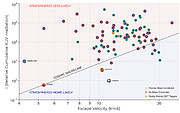sci25003 — Announcement
The Rocky Worlds Director’s Discretionary Time Programme
17 June 2025
-By Chris Evans-
The Rocky Worlds Director’s Discretionary Time (DDT) programme combines Hubble and Webb observations to search for evidence of atmospheres on rocky exoplanets orbiting around M-dwarf stars.
Starting in Webb’s Cycle 4, this new DDT programme will use 500 hours of MIRI observations to investigate the ‘Cosmic Shoreline’ concept of which rocky planets are able to retain an atmosphere. The observations will target transiting systems at their secondary eclipses to measure the dayside flux of the planet via their eclipse depths. If an atmosphere is present, there will be more energy recirculation so we expect a lower dayside flux, i.e. a smaller eclipse depth. The MIRI observations will be obtained at 15 microns, which probes the presence of a broad CO2 band that, if present, further reduces the flux and will give a stronger detection of an atmosphere.
To complement the Webb data, Hubble will obtain ultraviolet spectroscopy of the host stars, combining observations from its COS and STIS instruments. The spectra will be used to investigate the stellar UV irradiation experienced by the rocky planets, to help address the question of why there is an atmosphere or bare rock. The UV data will also provide time-series data to look for, and characterize, flares on the host stars.
To implement the programme and to process and release the data, a Core Implementation Team (CIT) has been assembled at STScI. The CIT is advised by a Science Advisory Committee (SAC) drawn from the user community. The membership of the CIT and SAC is available here.
Following community input on a provisional list of targets to be considered for the programme, the two first targets selected for observations were GJ 3939 b and LTT 1445 A c, with two additional targets newly announced on 17 June: LTT 1445 A b and LHS 1140 b. The first Webb and Hubble observations of GJ 3939 b will begin in the coming weeks. Further targets are now being discussed by the SAC and CIT, taking into account their science priority and feasibility. If selected, these will be announced in advance of the deadline for Webb’s Cycle 5 proposals (which will be on 15 October 2025).
All observations from the Rocky Worlds programme will have zero exclusive access period, so will therefore be immediately available for download and use once completed. The anticipated data products that will be produced and released by STScI from the 15 micron MIRI observations will include time-series photometry, eclipse depths and absolute fluxes, together with co-added, flux-calibrated, far- and near-UV spectroscopy of the host stars from Hubble.
Further details of the Rocky Worlds DDT programme and upcoming announcements on the next set of selected targets are available here.
Contacts
Chris Evans
ESA/HST & ESA/JWST Project Scientist
ESA Office, STScI Baltimore, USA
Email: [email protected]
About the Announcement
| Id: | sci25003 |
|---|


